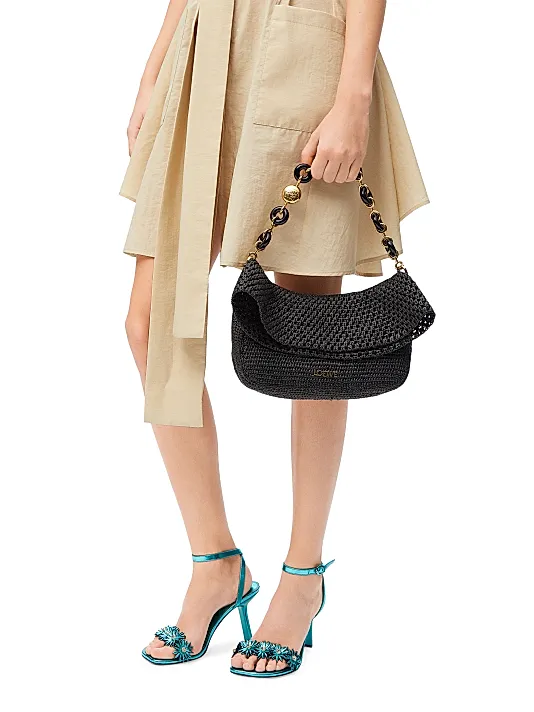When Colombian designer Silvia Tcherassi, 60, opened up her fashion business to wholesale in 2017, she had already established her luxury ready-to-wear label with 15 stores throughout South America, Spain and Miami. She also penned the book “Elegancia Sin Esfuerzos” in 2017, worked in interior design and became the founder and creative director Tcherassi Hotels, which is currently exploring new projects focused on hospitality and real estate after receiving acclaim for its previous hotels in Cartagena, Colombia.
Since then, the celebrated designer has expanded the vibrant world of her eponymous womenswear label alongside her daughter, Sofia Espinosa Tcherassi, who joined the business as director of ready-to-wear during the pandemic. Together, they continue to uphold their Colombian heritage through luxe craftsmanship and collaborations with local artisans, resulting in artfully feminine and glamorous fashions that are stocked at the brand’s 11 global stores, and with retailers such as Bergdorf Goodman, Saks Fifth Avenue, Neiman Marcus, Moda Operandi and more. The brand’s headquarters, design studio and showroom are based in Miami, while production facilities and logistics operations are in Colombia.
Silvia Tcherassi resort 2025
Courtesy of Silvia Tcherassi
“Having been born in the Caribbean [in Barranquilla, Colombia], with its rich culture and history, these factors have profoundly influenced my creative process. The Caribbean and Latin America are a fusion of diverse cultures and immigrants from many parts of the world, including Italy, where my grandfather originated. This has enriched Latin culture, making it diverse, eclectic and heterogeneous,” Silvia Tcherassi told WWD, adding that in her region, values of family and community, as well as creating a strong sense of belonging have influenced her as a creative. Furthermore, Latin American arts, music and literature consistently inspire her for their “unique identities and impart lessons that transcend their mediums,” she said.
“[Gabriel] García Márquez taught us that the ordinary can become extraordinary, a concept I incorporate into my designs. Similarly, Fernando Botero’s approach to volume, scale and color invites experimentation and the exploration of new visual languages,” Tcherassi said of previous collections’ inspirations.
She also credits Carolina Herrera and Oscar de la Renta, who were both born in the Caribbean, as inspirational designers who opened the doors for her generation and whose stories are not linked solely to a part of Latin American history, but have strongly impacted global history.
“In Latin culture, we are passionate about our work, putting love and dedication into everything we do. A job is not just a job, and a company is not just a company. There is an underlying passion that connects all elements, along with a strong sense of legacy. We focus not just on short-term results, but on building something meaningful for our families, communities and country. Our accomplishments are not seen as personal triumphs alone; when I debuted in Milan, Colombians and Latins felt that the success was also theirs,” Tcherassi said of being the first being the first Latin American designer invited to Milan Fashion Week in 2003 by the Camera Nazionale della Moda Italiana, as well as to Paris in 2004 by the Fédération de la Haute Couture et de la Mode. She added that being honored with the title of Chevalier of the Ordre des Arts et des Lettres by France has also made a significant impact on her career.
With each collection, Tcherassi upholds the value of hard work that she said is deeply ingrained in her culture, as well as the preservation of traditional craft of the “centuries-old techniques of our indigenous communities,” by collaborating with these artisan communities, such as the Wayuu Indigenous Community in La Guajira, Colombia and Artisan Community of Usiacurí in Atlántico, Colombia, for more than 15 years.

Silvia Tcherassi fall 2024
Courtesy of Silvia Tcherassi
“I strive to emphasize that being Latin is not just a demographic label but a cultural identity. Our culture is incredibly diverse, and as a result, so are the creatives from the region. The work of Gabriela Hearst, Adrian Appiolaza, Willy Chavarria and myself is vastly different, even though we share a Latin connection. We don’t necessarily share a design manifesto, which enriches our work and makes it more special — we cannot all be placed in the same box,” Tcherassi said.
“Latin designers are gaining more recognition in the fashion industry. For years, European fashion houses drew inspiration from our region — Dior’s haute couture looks inspired by Peru, Colombian accessories on Gaultier’s runway and Riccardo Tisci’s work for Givenchy inspired by Frida Kahlo. Today, we are telling our own stories and representing our culture on our own terms,” she added of how being a Hispanic designer has evolved over recent years.
However, this representation — ”genuine representation, not the perpetuation of clichés and stereotypes,” she said — and visibility needs to continue to grow.
“Hispanic Heritage Month is important because it highlights the achievements of Latinos in various fields, serving as inspiration for newer generations. These stories, which show how to achieve dreams while staying grounded, can motivate younger individuals to reach their full potential and find their own personal and professional paths,” Tcherassi said.
In honor of Hispanic Heritage Month, WWD chose 10 Latino designers who are shaping the world of fashion today to photograph and profile. The images from this series will be featured in a national billboard campaign run by Outfront.

















